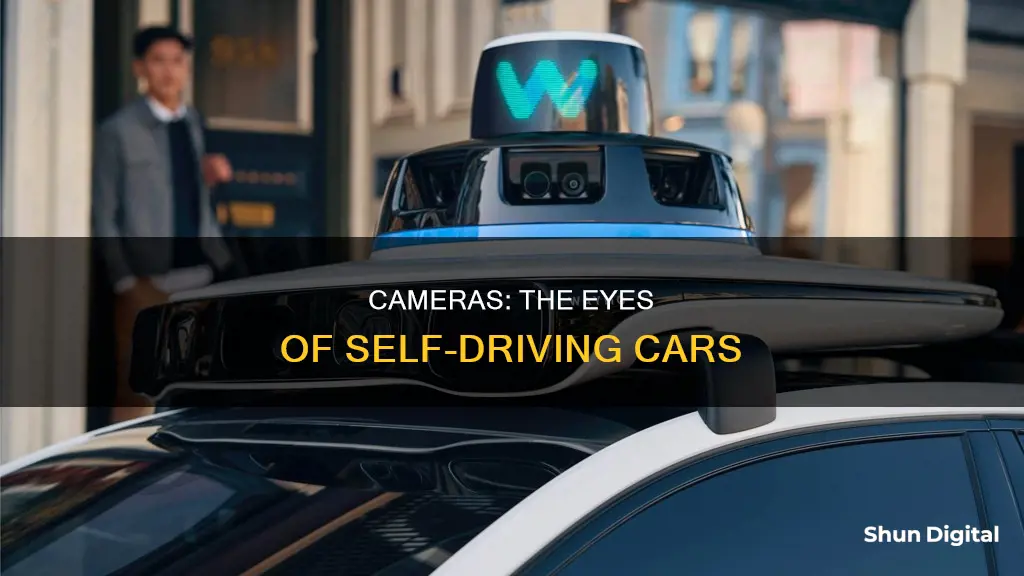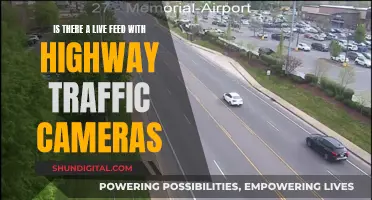
Self-driving cars use a combination of cameras, radar and lidar sensors to mimic the human ability to see and understand the world around them. Cameras are a critical element of this system, providing visual data that is returned from the optics in the lens to an on-board software for analysis. This enables self-driving cars to understand their environment and make decisions about how to apply the throttle, brake and steering.
| Characteristics | Values |
|---|---|
| Purpose | To provide a visual representation of the world for self-driving cars |
| Positioning | Front, rear, left, and right of the car |
| Field of View | Wide-angle (up to 120 degrees) or narrow-angle |
| Camera Types | Fish-eye, stereo, CCD, CMOS |
| Advantages | High resolution, cheap, good for classification and scene understanding, colour perception |
| Limitations | Struggle in different weather and lighting conditions, lack depth perception, require a lot of processing |
What You'll Learn

Cameras are one of the main sensors used in self-driving cars
Cameras are good at high-resolution tasks such as classification, scene understanding, and tasks that require colour perception like traffic light or sign recognition. They can distinguish details of the surrounding environment but struggle to calculate the distances of those objects. This is where other sensors like lidar and radar come in, as they can detect the speed and location of objects.
Cameras have their limitations. They struggle in low-visibility conditions, such as fog, rain, or at night. They also require a lot of processing power to extract information from the visuals they capture. Despite these limitations, cameras remain a critical element in self-driving cars, providing the necessary visual data for the vehicle to understand its surroundings.
Some companies, like Tesla, are at the forefront of a camera-only movement for self-driving cars. They argue that since humans can drive with only visual input, so too should self-driving cars. Tesla has been collecting data from the millions of cars it has sold worldwide to train its deep learning models. With advancements in neural networks and computer vision algorithms, Tesla believes that cameras alone can enable a full robot takeover of driving.
While the camera-only approach is promising, most self-driving car companies are reluctant to put full trust in image processing alone and continue to rely on other sensors like lidar and radar. The argument for a multisensor approach is that it provides redundancy and improves safety, ensuring that the self-driving car can detect objects in all lighting and weather conditions.
Is Your Camera Battery Charged? Check This Way
You may want to see also

Cameras help cars understand their environment
Cameras are an essential component of self-driving cars, providing them with a visual understanding of their environment. Placed on every side of the vehicle, cameras capture images and videos of the car's surroundings, which are then stitched together to form a 360-degree view. This panoramic view enables the car to perceive and interpret its environment, much like human eyesight.
Cameras, being the most accurate way to create a visual representation of the world, play a crucial role in self-driving cars. They can distinguish fine details in the environment, such as lane lines, road signs, and even a cyclist's arm sticking out to signal a turn. This level of detail is vital for the car to make sense of its surroundings and navigate appropriately.
In addition to detail, cameras also provide depth perception, especially when used in stereo setups. This depth information helps the car understand the distance and position of nearby objects. However, one of the limitations of cameras is their struggle in low-visibility conditions, such as fog, rain, or at night. To compensate for this, self-driving cars often use radar or lidar sensors alongside cameras to enhance object detection in such challenging conditions.
The images captured by cameras are analysed using advanced machine-learning techniques and artificial intelligence. These technologies enable the car to recognise objects, interpret signs, and make sense of its environment. For example, with enough data and computing power, AI systems can be trained to identify objects, such as other vehicles, pedestrians, and road signs, and make driving decisions accordingly.
The combination of cameras and AI technologies has led to significant advancements in self-driving car capabilities. While there is ongoing debate about the best approach for self-driving cars, with some favouring the inclusion of lidar or radar sensors, cameras remain a fundamental and indispensable component, providing self-driving cars with the visual understanding necessary for safe and effective navigation.
Disabling Surveillance Cameras: Quick and Easy Tricks
You may want to see also

Cameras can be used in conjunction with LiDAR technology
Another advantage of using cameras with LiDAR is improved performance in poor lighting and adverse weather conditions. Cameras rely on light to perceive their surroundings, and their visual recognition capabilities are affected by shadows, bright sunlight, or oncoming headlights. In contrast, LiDAR systems operate effectively in any lighting condition and are not fooled by shadows or bright lights. By integrating cameras with LiDAR, self-driving cars can benefit from the strengths of both technologies, improving their ability to navigate in challenging lighting and weather situations.
Additionally, the combination of LiDAR and cameras can enhance the safety of self-driving cars. While cameras offer excellent visual recognition, they lack the range-detecting capabilities of LiDAR. LiDAR, on the other hand, provides accurate distance measurements and object detection, making it ideal for collision avoidance and braking systems. By fusing the data from both sensors, self-driving cars can have a more robust understanding of their surroundings, improving their safety and decision-making abilities.
The integration of cameras and LiDAR also addresses the limitations of relying solely on one technology. For example, cameras are more cost-effective and easier to incorporate into vehicle designs, while LiDAR provides more accurate and precise data but is generally more expensive. By using both technologies together, self-driving cars can benefit from the strengths of each, creating a more robust and well-rounded perception system.
Furthermore, the combination of LiDAR and camera systems allows for redundancy and failsafe mechanisms. Should one system encounter a failure or malfunction, the other system can still provide critical data for navigation and object detection. This redundancy improves the overall reliability and safety of self-driving cars, especially in complex or unpredictable environments.
Surveillance Camera Cable Installation: A Step-by-Step Guide
You may want to see also

Cameras can be used to read text on road signs
Cameras are an essential component of self-driving cars, helping them to perceive and understand their surroundings. One of their key functions is to read text on road signs, enabling the car to make sense of its environment and make appropriate driving decisions.
Road signs are designed to be easily recognisable to human drivers, with bold colours and blocky shapes that stand out from a distance. Self-driving cars, on the other hand, rely on advanced image processing techniques and pattern recognition algorithms to interpret these signs. This is where cameras come in.
Cameras on self-driving cars are typically positioned on the roof or sides of the vehicle, often in stereo setups, allowing them to capture clear images of lane lines and road signs. These cameras have high resolutions, capable of recognising hand signals or an arm sticking out to signal a turn. They rely on illumination from the sun or headlights, however, and can be hindered by poor weather conditions.
To interpret road signs, self-driving cars use a combination of colour-based, shape-based, and learning-based methods. They are trained using large datasets of predefined traffic signs, employing deep learning techniques to 'learn' and improve their accuracy over time. This enables them to identify a variety of signs, including speed limits, turn signals, and warning signs such as "children" or "school ahead".
While cameras play a crucial role in reading road signs, they are not perfect and can be fooled. Adversarial attacks, such as placing stickers or tape on signs, have been shown to confuse the computer vision systems of self-driving cars, causing them to misinterpret signs or fail to recognise them altogether. To mitigate this, self-driving cars may use other sensors and mapping technologies to cross-reference the information captured by their cameras, improving their overall accuracy and safety.
High-Res Mode: Unlocking the Power of Pen F Camera
You may want to see also

Cameras are cheaper than other sensors
Environmental sensing technology is essential for self-driving cars. Cameras, lidar, and radar are the three primary mechanisms used by self-driving cars to sense their environment. Cameras are one of the most popular mechanisms as they can visually sense the environment in a similar way to human vision.
Cameras are much cheaper than lidar systems, which brings down the overall cost of self-driving cars, especially for end consumers. They are also easier to incorporate into vehicles, as off-the-shelf cameras can be purchased and improved upon, rather than requiring the invention of entirely new technology.
Lidar, on the other hand, is a newer technology that uses an array of light pulses to measure distance. It is incredibly accurate and precise, but it is also costly. Google's system, for example, originally cost upwards of $75,000. While startups have brought down the costs of lidar units, it still remains to be seen how many of these units will be needed per vehicle. Therefore, lidar costs can add a significant cost to consumer vehicles and will likely be used in the realm of autonomous fleet vehicles for a little while longer.
In addition to being cheaper, cameras also have other advantages over lidar. For instance, cameras are not affected by fog, rain, or snow, whereas lidar has limitations in these conditions. Cameras can also see the world and read signs and interpret colors in the same way that humans do, unlike lidar. Furthermore, cameras can be easily incorporated into the design of the car and hidden within the car's structures, making them more appealing for consumer vehicles.
Editing Essentials: Camera Raw CS3 Techniques
You may want to see also
Frequently asked questions
Cameras are used to create a visual representation of the world around a self-driving car. This helps the car understand its environment and make decisions about how to drive.
Cameras are placed on every side of the car to stitch together a 360-degree view of the car's environment. Some cameras have a wide field of view, while others focus on a narrow view to provide long-range visuals. The cameras use visual data returned from the optics in the lens to an on-board software for analysis.
Cameras are very good at high-resolution tasks such as classification and scene understanding. They are also relatively cheap compared to other sensors like radar and lidar. Additionally, cameras can read text from road signs, which is important for the car to be aware of road work or detours ahead.
Cameras struggle to perform well in different weather and lighting conditions. They also require a lot of processing power to extract information from the visuals.







